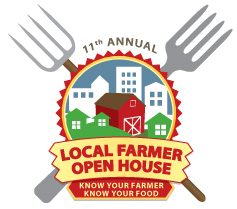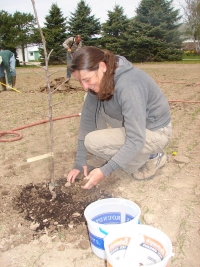Turtle Creek Gardens, is a division of GRVWFarms, LLC, located just north of Delavan, in the southeastern corner of Wisconsin. The farm was named for geographical features in the area: Turtle Creek (meandering to the east), Turtle Creek State Wildlife Area, Turtle Valley Conservation Area, and Turtle Lake (just north of the farm).
Seventeen acres of the 80-acre farm have been set aside for vegetable and fruit production. The remaining acreage is pasture, which is home to 75 head of cattle, shared between Geary-Wolf Farms, LLC (an affiliated entity) and VDB Organic Farms, Bob and Beth Van De Boom. Bob and Beth own an additional 40 acres and manage the grazing lands and cattle, along with 100 laying hens.
The 17 acres designated for vegetable and fruit production were formerly planted in conventional corn and soybeans. Transitioning land from conventional agriculture to organic agriculture is a process that requires three years under the USDA's National Organic Program standards. This process builds fertility and enhances microbial life in the soil.
As a soil-building strategy, cover crops are used to protect the soil from erosion, build top soil, and stimulate microbial activity, which is the main source of fertility on an organic farm. In their case, they chose winter rye and red clover as their cover crop mix.
Over the course of 2010, the Turtle Creek crew constructed two major outbuildings for growing their crops: the greenhouse and the season extension hoop house.
“A greenhouse isn't just for starting spring crops; it is used throughout the season to sow continuous successions of crops,” explained Janet. Lettuce, for example, needs to be sown every two weeks to provide a weekly allotment of this crop to CSA members. The greenhouse allows the farm to have multiple spring and fall successions of the Brassicas (the mustard family) which includes broccoli, cauliflower, cabbage, kale, turnips and brussels sprouts
The greenhouse also allows a head start on growing heat-loving plants like basil, tomatoes, peppers, eggplant, cucumbers, melons and summer squash, rather than waiting until it is warm enough outside. Generally, all of these plants do better if started in a greenhouse as it provides a protective environment. A greenhouse acts like an incubator for plants until they can be moved to a transitioning space known as the "hardening-off area". Most hardening-off areas consist of structures with walls that can be removed, or opened and closed as weather permits. Once hardened, these crops can be transplanted as vigorous plants better able to fend off predators and abusive weather.
The second outbuilding constructed in 2010 was the season extension hoop house. This building is similar in size (30x72 ft) and construction to the greenhouse, except it has only one layer of heavy plastic.
Hoop houses primarily serve as a heated space to grow plants in the ground. The clear plastic traps heat from the sun, which warms the soil inside the hoop house, so it can be used earlier in the spring and later in the fall to grow crops that normally do not grow well in the cold, thus extending the normal outdoor season. Hoop houses are also commonly used for growing plants such as tomatoes, peppers, and eggplants, among others which thrive in hotter temperatures.
During the first year at the farm, perennial crops of fruit trees, berries, rhubarb and asparagus were planted. With a group consisting of CSA members and friends, Janet planted more than 40 dwarf apple, pear and peach trees and several rows of raspberries, currants, black berries and strawberries. TCG will continue to bring in fruit from other farms until their trees are mature enough to produce.
In 2011, they started honey bee hives on the farm. TCG is establishing a diverse landscape with hedgerows for beneficial insects and their bees.
This blog post was written by Theresa Lins. Theresa is a Milwaukee-based writer and Urban Ecology Center “groupie”. She has been active in promoting the Center and its programs for over 14 years. Other than eating farm-fresh food, her favorite thing is to write about it and the people who produce it.
 You can meet these farmers and many others at the Local Farmer Open House on March 9th at our Riverside Park branch. Meet and sign up with farmers, learn how you can join a CSA farm (purchase a share of the harvest) and get a box of fresh produce each week during the season. Join us for this free event!
You can meet these farmers and many others at the Local Farmer Open House on March 9th at our Riverside Park branch. Meet and sign up with farmers, learn how you can join a CSA farm (purchase a share of the harvest) and get a box of fresh produce each week during the season. Join us for this free event!





